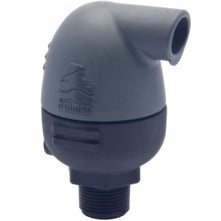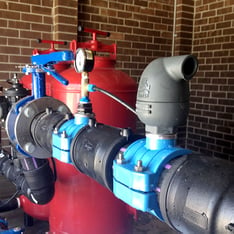Enhancing Air Control in Water Systems with a Combination Air Valve
A combination air valve helps ensure optimal water system efficiency.…
Did You Update BERMAD Connect Already? Check It Out
Update BERMAD Connect Today! Check It Out
BERMAD > Knowledge Center > Blog > How Automatic Air Valves For Your Irrigation System Maintains Efficiency

By
Imagine this scenario:
Your irrigation system has been working flawlessly, and you are looking forward to your best harvest ever. But suddenly, you notice that some of your plants are starting to droop.
You check the soil: bone dry in patches. Panicked, you start inspecting your irrigation lines. First, you inspect the emitters near the dry areas, thinking some of them may be clogged. No problem there. Then you check for leaks. Nothing. Your pumps seem to be working fine, but the pressure is down in some of the lines. What can the problem be?

Chances are, you’ve got an issue with entrapped air. This is a very common problem in irrigation systems, especially in cases where agricultural water supply is discontinuous. Whether for energy efficiency reasons, water sharing, or another reason, many agricultural irrigation systems are subject to frequent water supply interruption. This tends to introduce extra air into the system.
Entrapped air in an irrigation system can lead to serious problems, including:

If you are experiencing air build-up in your irrigation system, you will need to regularly and efficiently discharge it in order for your system to work effectively. Fortunately, there is a simple solution for doing this: install one or more automatic air valves.
An automatic air valve is designed to release small amounts of air from a pressurized line. As air accumulates in the upper part of the air valve chamber, it causes the float to gravitate downwards. This in turn cases the automatic orifice to open, releasing the accumulated air. Once the air is discharged, the water level and float rise, causing the automatic orifice to close. The valve helps maintain proper water pressure and consistent flow; releases air bubbles and prevents air locking of the system; and ensures that the system’s hydrometers are measuring water, not air volume, so that the correct amount of water reaches the crops.
Since air travels at the top of pipelines and rises in water, automatic air valves should be placed at high points in your system where air tends to collect. Place automatic air valves at any location where you have a high spot on your pipeline, and at high points at your pumping stations, control heads, and filter stations. It’s also a good idea to place them near water meters and automatic pressure regulators to ensure proper functioning of these essential components.
As part of our new family of irrigation air valves, BERMAD has recently introduced the model A10 and model A30 automatic air valves. These valves have a number of distinguishing features that make them ideal for agricultural irrigation applications.

Both valve models are available with a ¾” or a 1” orifice. The A30 is pressure rated to PN16, while the A10 is rated to PN10. The A10 also features a boss on the base which can be tapped with a thread for installation of remote pressure sensors or gauges, Schrader valves, or test drains.
Like all our products, BERMAD air valves are backed by application engineers and customer support teams offering design and implementation consulting, surge analysis, and online sizing for system optimization. To learn more about BERMAD air valves, or for assistance in determining which air valves will best serve your needs, contact us here to connect with a BERMAD representative in your area.


We got your email. Now, let’s make it personal...
